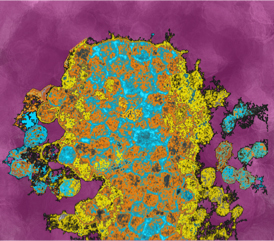

Artistic 3D rendering showing progenitor cells in a zebrafish
Vanessa Barone / IST Austria
The average human consists of about 37.2 trillion cells. But not all cells are created equal: while muscle cells contain the molecular machinery to contract and relax your muscles, some neurons send meter-long axons from the spinal cord to the tip of your toes, and red blood cells bind oxygen and transport it around the body. How does a cell “know” which function to fulfil?
In a paper published today in Developmental Cell, the group of Carl-Philipp Heisenberg at the Institute of Science and Technology Austria (IST Austria), including first author and PhD student Vanessa Barone, sheds light on how a cell’s fate is determined. They for the first time report a positive feedback loop between the duration of cell-cell contacts and the specification of a cell’s fate.
In our bodies, cells do not just sit next to each other. Instead, neighbouring cells can form contacts with each other: connections of different size, strength and duration which reach from one cell to another. Heisenberg and his group used the zebrafish, a small fish frequently used to study animal development, to investigate whether signalling between cells and cell-cell contact formation affect each other, and influence how a cell’s fate is determined.
The researchers looked at progenitor cells within the forming anterior axial mesendoderm that give rise to either the head mesoderm or endoderm of the developing embryo. In this system, the authors identified a positive feedback loop between cell-cell contact formation and cell fate specification: when mesendoderm progenitor cells form long-lasting cell-cell contacts, the cells become head mesoderm, while in case they only form short-lasting contacts, they will form endoderm.
Cell-cell contact formation and cell fate specification promote each other by contact formation triggering high Nodal/TGFβ-mediated cell-cell signalling, required for head mesoderm cell fate specification and differentiation, and Nodal signalling, in turn, promoting cell-cell contact formation. The authors thereby identify cell-cell contact duration – as opposed to e.g. the number or size of cell-cell contacts – as a key feature in controlling the level of cell-cell signalling determining binary cell fate decisions during embryonic development
Carl-Philipp Heisenberg, an elected member of the European Molecular Biology Organization (EMBO) as well as of the Leopoldina —the German National Academy of Sciences—, joined IST Austria in 2010. He and his group study vertebrate morphogenesis using multi-disciplinary approach employing a combination of genetic, cell biological, biochemical and biophysical techniques.
Earlier this year, he obtained an Advanced Grant of the European Research Council. First author Vanessa Barone was a student in his group and graduated from IST Austria’s PhD program this summer. The interdisciplinary graduate school of IST Austria which she attended offers fully-funded PhD positions in the natural and mathematical sciences: http://phd.ist.ac.at/
IST Austria
The Institute of Science and Technology (IST Austria) is a PhD granting research institution located in Klosterneuburg, 18 km from the center of Vienna, Austria. Inaugurated in 2009, the Institute is dedicated to basic research in the natural and mathematical sciences. IST Austria employs professors on a tenure-track system, postdoctoral fellows, and doctoral students at its international graduate school. While dedicated to the principle of curiosity-driven research, the Institute owns the rights to all scientific discoveries and is committed to promote their use. The first president of IST Austria is Thomas A. Henzinger, a leading computer scientist and former professor at the University of California in Berkeley, USA, and the EPFL in Lausanne, Switzerland. http://www.ist.ac.at












